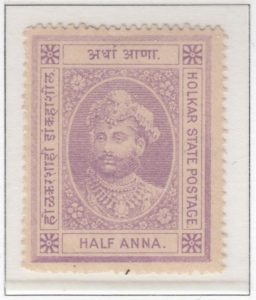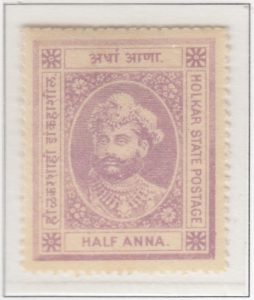
Population: 850,690 (in 1901)
Indore (also referred to as Holkar) was a Princely state in the Indore Agency in Central India (presently part of the Madhya Pradesh State). The first stamps were issued in 1886 during the rule of Maharaja Tukoji Rao II Holkar who reigned from 1844 to 1886.
The stamps consisted of ¼ Anna of various shades of mauve. They were lithographed, gummed and perforate 14 ½ – 15. They were printed on thick white paper or thin white paper or yellowish paper.
Click here to see all stamps from Indore in this exhibition.
History
The history of Indore is one of progressive development against a backdrop of intermittent intrigue and scandal. Under successive rulers, including Maharaja Tukoji, who issued the first stamps, the state modernized, instituting reforms in transportation, commerce, agriculture, education, and electrification. This continued under successive rulers. Women played an intermittent – but important – part of state affairs, in ways sometimes colorful or scandalous.
In 1728, Indore originated in a grant of land by the Maratha Empire to a cavalry officer of the Holkar family. By 1767, a daughter-in-law, Ahilyabai Holkar, had officially become ruler. Reigning until 1795, she led armies, developed Indore into a prosperous city, built many structures, and encouraged a textile industry.
In 1811, with the British East India Company vying for power in the area, co-regent Maharani Tulsabai Holkar, who was then serving as regent, discovered a plot against her and her young son, and had the conspirators assassinated. In turn, she was murdered, and a treaty was signed with the British. More uprisings against the British followed but, at the end of the Third Anglo-Maratha war, Indore was a British protectorate, albeit with reduced territory.
More than a century later, east and west again collided with a story of harem scandal. In 1926, Maharajah Tukoji Rao was accused of murder in a case of love gone wrong. A member of his harem – introduced to the court at age 13 – escaped into the protection of a lover. In turn, the Maharajah’s men murdered the lover and badly injured the girl. Perhaps most remarkably, the girl was able to pursue her case in court (using the Muslim language of Urdu), claiming that she had been held prisoner, and that attendants had murdered the female child she had had by the Maharajah. In the ensuing scandal, the Maharajah was forced to resign, claiming all the while that the intervention of the British in internal affairs was harmful, if not illegal.
Shy, awkward, and unprepossessing, British educated Yeshwant Tukoji Rao inherited the throne in 1926. After his beautiful and vivacious Maharini died in her 20s, he remarried two westerners, the first, scandalously, a divorcee, who soon added a divorce to Yeshwant to her dossier. These morganatic marriages were made more acceptable because Yeshwant named his daughter from his first – Indian – marriage, Usha, as his heir. Despite his colorful personal life, development and modernization in Indore proceeded apace.
In turn, Usha has become a hands-off inheritor of the throne. Married to a Mumbai-based billionaire, she visits Indore, which acceded to India peacefully, only rarely.
Indore (Holkar)
1886


